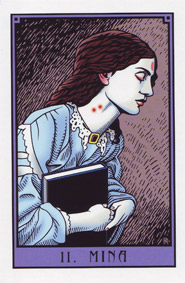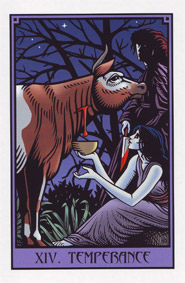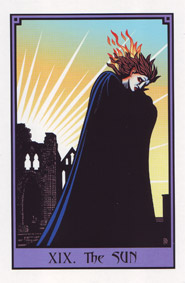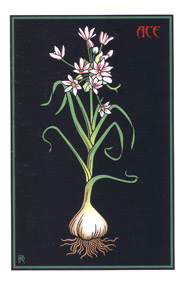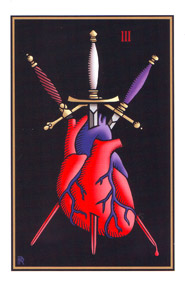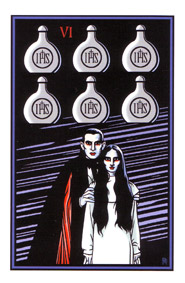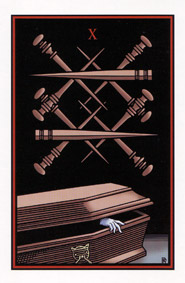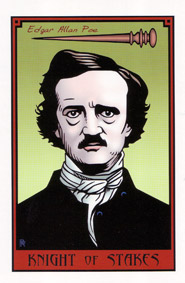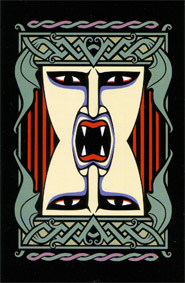Vampire Tarot Deck Review
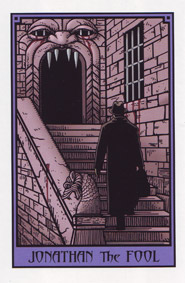
The Vampire Tarot draws together tarot, Bram Stoker's novel Dracula and vampire myths over the ages. From Robert M. Place, who created the Alchemical Tarot and Tarot of the Saints, it is a well-researched and deep look at the links between tarot and vampires, and is illustrated in his distinctive artistic style. The set also includes an excellent companion book.
Deck Type: Tarot Deck Cards: 78
Creators: Robert M. Place
Publisher: St Martins Press 2009
Retailers
See Price at Amazon.comSee Price at Amazon.co.uk
See Price at Amazon.ca
Vampire Tarot Review by Bonnie Cehovet
I very much look forward to any new project that Robert Place is involved in. Amongst his gifts to the Tarot world are the co-authoring and illustrating of the Alchemical Tarot and the Angels Tarot, authoring and illustrating the Tarot of the Saints and the Buddha Tarot, and the critically acclaimed Tarot: History, Symbolism and Divination, as well as Astrology and Divination, Shamanism, and Magic and Alchemy. He holds lectures and workshops related to the Tarot, and conducts teleclasses through the Tarot Connection.
In the Vampire Tarot, Place combines the world of the vampire, starting with Bram Stoker’s 1897 novel Dracula, and the world of Tarot in an ingenious mixture of magick and mystery. This is a traditional 78 card deck, accompanied by a 227 page companion book. The Major Arcana titles remain the same, with the exception of Mina (The High Priestess), The Brides (The Empress), The Count (The Emperor), Van Helsing (The Hierophant), The Wagon (The Chariot), Fate (The Wheel of Fortune), and The Madman (The Hanged Man). Justice is VIII, Strength is XI. The suit titles are: Stakes (Wands), Holy Water (Cups), Knives (Swords) and Garlic Flowers (Coins/Pentacles). The court card titles are King, Queen, Knight and Knave.
The Court cards depict historic individuals/fictional characters that were influential in developing the vampire myth in modern literature. The Kings are Sir Henry Irving (suit of Holy Water), Lord Byron (suit of Knives), Bram Stoker (suit of Garlic Flowers), and Franz Liszt (suit of Stakes); The Queens are Pamela Colman Smith (suit of Holy Water), Ellen Terry (suit of Knives), Florence Stoker (suit of Garlic Flowers), and Charlotte Stoker (the suit of Stakes); the Knights are Joseph Sheridan Le Fanu (suit of Holy Water), Samuel Taylor Coleridge (suit of Knives), John Polidori (suit of Garlic Flowers), and Edgar Allen Poe (suit of Stakes); the Knaves are Carmilla (suit of Holy Water), the Night-Mare of Life-in-Death (suit of Knives), Lord Ruthren (suit of Garlic Flowers) and Ligeia (suit of Stakes).
The companion book is a stand-alone gem on its own. It is the product of a tremendous amount of research, combined with a clear and deep understanding of the Tarot. In his introduction Place refers to the literary vampire as an ancient mythological figure that addresses the issues of mortality and the nature of the soul (as does the Tarot). Place also feels that Stoker’s Dracula was directly influenced by the Tarot, with many of his characters being based on the Tarot trumps.
There are compelling sections on both the history and philosophy of the Tarot (including little tid bits such as a graphic of Ptolemy’s ladder of the planets, a rendering of the fifteenth century Goldschmidt card depicting the World as the Grail, and a rendering of Le Mat (The Fool) from the Francois Chosson Tarot, 1672) and the Vampire in legend and art.
In his introduction to the Minor Arcana Place includes a table associating the four suits of the Tarot with the Slayer tool (holy water, knives, garlic flowers and stakes), class (clergy, nobles, merchants and peasants), element (Water, Air, Earth and Fire), Humor (phlegm, blood, black bile and yellow bile), and Jungian function (intuition, thinking, sensation and feeling).
Each card is presented in text only (no scans), with a general discussion of the card. Each Major Arcana card is prefaced with quotes from the book Dracula. At the end of the book there are instructions for reading the Three-Card Message, the Relationship Spread and the traditional Celtic Cross.
The cards themselves are 3 ˝” by 5 1/2 “, on high quality, glossy cardstock. The backs have a black border, surrounding a reversible “mask” of a vampire with fangs. The card faces show a white border, with a thinner inner colored border, with the colors coded to the five suits. At the bottom of the card is the card number in Roman numerals and the title (for the Major Arcana), and the card title and suit (for the Court Cards). The Minor Arcana Pips (numbered cards) carry the suit image within the card, and the card number, in Arabic numerals, along the top of the card.
The box that the deck and book come in is first class – heavy cardboard, with a lift off top. The bottom is black, with black sides and information on the back. There is a plastic insert to hold the cards, with the book fitting on top. The top of the box is red and black, and carries a picture of Dracula. The cards tend to stick together when they are first opened, but they can be taken apart easily with no harm done.
I am very impressed with the Gothic quality to this deck – very dark, but edgy and “real”. In the card of the Fool we see Jonathon walking up the staircase to the castle, carrying his suitcase. At the top of the stairs is the entry, topped by eerie eyes and fangs. The Magician shows Count Dracula with his arms raised against the night sky.
In The Hierophant we see Van Helsing standing in front of a window in his study, a cross held in front of him in his left hand and a determined look on his face. The Hermit shows an emaciated vampire standing in the wilderness, holding up a candle in his right hand, as if beckoning us to follow him. The Minor Arcana are done semi-Marseilles style, with the suit icons and a minimal graphic addition.
I loved the stunning artwork and the four-color style to this deck. I feel that these cards could be used with most clients without a problem as there really is no gore – only subtle nuances. There are also little add-ons, like the use of scenes derived from the story of Dracula, and imagery from vampire films and novels in illustrating the Pips. And then there is the metal bottle with the monogram of Jesus engraved on the side in the suit of Holy Water.
This is definitely a collectors deck, and a deck for those that are drawn to the vampire theme. It is a playful deck, and can really be used by anyone. The companion book draws not just from the world of Vampires, or the world of Tarot, but from the encyclopedia knowledge that Place has about mythology and all things esoteric. This is a keeper!
© Bonnie Cehovet
Complete Details of Vampire Tarot
Creators: Robert M. PlacePublisher: St Martins Press 2009
Deck Type: Tarot Deck
Cards: 78
Major Arcana: 22
Minor Arcana: 56
Deck Tradition: Mixed
Minor Arcana Style: Unique Scenes With Suit Symbols
Suits: Stakes, Knives, Garlic Flowers, Holy Water
Court Cards: Knave, Knight, Queen, King
Card Size: 3.50 x 5.28 in. = 8.89cm x 13.40cm
Card Language: English
Card Back: Reversible
Back Design: Stylised mirrored depiction of fanged pale vampire.
Companion Material: 228 page book by Robert M. Place
Rating: 20/20 or
Similar Decks to Vampire Tarot
Theme: Dark & Gothic, VampireCreator: Alchemical Tarot, Alchemical Tarot: Renewed, Angels Tarot, Annotated Tarot of the Sevenfold Mystery, Buddha Tarot, Tarot of the Saints, Tarot of the Sevenfold Mystery, The Burning Serpent Oracle by Robert M. Place
< Previous Deck · Back to Top · Next Deck >
Home > Tarot Reviews > Vampire Tarot Review

